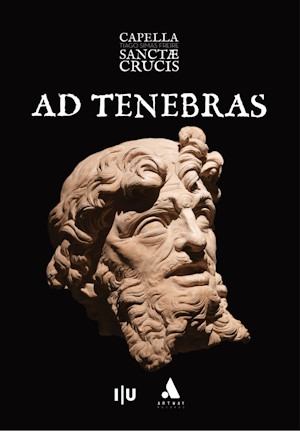
Ad Tenebras
Lamentations and Responsories for the Holy Week from the Monastery of Santa Cruz in Coimbra, 1530-1630
Capella Sanctæ Crucis/Tiago Simas Freire
rec. 2023, Palácio de São Marcos, São Silvestre, Coimbra, Portugal
CD & 56 page booklet (Coimbra University Press)
Notes and sung Latin texts and translations in Portuguese, English & French
Artway Records AWR023006 [76]
This new release from Portugal presents “an overview of the music intended for these Offices of Tenebrae found in sources from the Monastery of Santa Cruz in Coimbra, today preserved in the General Library of the University of Coimbra (BGUC) and following what might have been their original liturgical order.” It is explained that the Book-CD format “allows written narrative, iconographic illustration and recorded music to go hand in hand, the result of philological and artistic research into musical manuscripts and prints.”
The music itself has been culled from Santa Cruz Monastery manuscripts. The programme consists of six tracks for each of the three days beginning with Feria Quinta in Coena Domini (Maundy Thursday – the Last Supper), then Feria Sexta in Passione Domini (Good Friday – the Passion), concluding with Sabatto Sancto (Holy Saturday). The beautifully illustrated booklet provides photos of the performers, pages from the manuscripts employed and sculpture of the period, and guidance on the liturgical context of the music; it also explains that the accompaniment of the four voices by a recorder consort follows speculation on what might have been the norm based on regulations and documents of the period from Portuguese monasteries and cathedrals. While the texts will be familiar to collectors acquainted with Tenebrae by other, better-known composers, the Capella Sanctæ Crucis has sought out musical repertoire here which will be unknown even to enthusiasts: “More than an ensemble, it is a project to rescue a very rich and little-known musical heritage. Each concert is a new discovery of true sound cathedrals sleeping in the Portuguese archives. Each programme is a new page in its Music History.”
Obviously this music is here performed one voice per part and the A pitch is fixed surprisingly high at 460 Hz (modern pitch now usually being 440); it is not explained why this is the case. The ensemble has aimed to reproduce what they believe to be the authentic pronunciation of Latin in that era and location. The majority of the tracks are around the three or four-minute mark, but the opening Lamentations of the Prophet Jeremiah lasts nearly a quarter of an hour, incorporating biblical texts introduced by the first five letters of the Hebrew alphabet, ranging from Aleph through to Heth. The recorded acoustic is nicely atmospheric, close yet paradoxically spacious with quite a long reverberation of several seconds, but not muddy or congested – every strand of the voices is crystalline. While they are clearly singing in period style with minimal vibrato they invest every phrase with great emotion. Melismata and other ornamentations are neatly executed. Given that we are listening to only four voices, textures are surprisingly dense and rich; co-ordination and intonation are tight and accurate and the harmonies are delicious. Mezzo-soprano Camille Fritsch sings “Vau”, track 3, solo, with great intensity and expressiveness and especially haunting is the male alto a cappella solo in Lamed, “Matribus suis dixerunt”, track 9. Track 11 is purely instrumental – captivating in its brief, burring, buzzing sonority. The mood is not always sombre; there are more animated interludes, such as the urgent “Vox fugam” passage concluding track 4 – but the disc is a generous seventy-seven minutes, so I nonetheless advise listening in sections to avoid stylistic overload – perhaps a day at a time. One of the most complex numbers is track 13 with the two upper voices entwining above a single recorder’s sinuous line and next track is pleasingly underpinned by a firm, resonant bass line; indeed, there is something different about every piece to tickle the ear, despite a certain homogeneity of aural landscape inevitably perceived by the modern ear which has been exposed to all the schools of music since. The chirping of birds in the background at the end of the final track somewhat alleviates the undiluted sorrow and sobriety of its bleak beauty.
The recorders do not enter until the brief introduction to the Daleth section, then are silent again until the second track – and if you are thinking, as was I, of the recorders we played at school, think again: these are instruments three, four and – in the case of the bass dulcian – even seven feet long, the latter much taller than the player, hence the warm, mellow sound they produce, like organ pipes. Their counterpoint contribution to O vos omnes (track 5) over the tenor is most seductive.
This is a sound to transport you back four and five hundred years, both contemplative yet also rhapsodic.
Ralph Moore
Availability: Artway Records
Voices:
Camille Fritsch (mezzo-soprano)
Sylvain Manet (alto)
Almeno Gonçalves (tenor)
Luís Neiva (bass)
Recorders:
Tiago Simas Freire
Pedro Sousa Silva
Carlos Sánchez
José Rodrigues Gomes


















